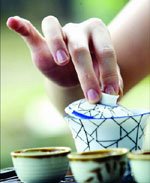In reading the original text of the Chajing (茶经), or Classic of tea, I made the following observations about his comparision of Tang era teabowls.
Lu Yu mentions the teabowls of 7 areas, or kilns. And he compares them. He states which ones are suitable for tea, and which bowls are inferior. Mainly, he compares the tea bowls on the basis of color. Of the 7 he compared, only 2 types were suitable for tea.
First he mentions Yue ware (越窑). He labels these teabowls superior. This teaware originates in modern Zhejiang province.
Second he mentions Ding Zhou ware (鼎州窑). Dingzhou ware is inferior. It comes from modern Shaanxi province.
Third, he mentions Wuzhou ware (婺州窑). It’s also inferior. It comes from modern Jiangxi province.
Fourth, he mentions a different Yue ware (岳窑). He pronounces is superior. It comes from modern Hunan province.
Fifth, he mentions Shouzhou ware (寿州窑). It’s labelled inferior. It comes from modern Anhui province.
Sixth, he mentions Hongzhou ware (洪州窑). It’s also inferior. It comes from modern Jiangxi province.
Seventh, he mentions Xing ware (邢窑). In his text, he only states it is inferior to Yue ware of Zhejiang. Xing ware came from modern Hebei province.
He goes on to say:
“If Xing ware is silver, then Yue ware is jade. This is one reason why it is not as good as Yue ware. If Xing ware is snow, then Yue ware is ice. This is a second reason. Xing ware is white, which makes the tea color red. Yue ware is green, which makes the tea color green. This is a third reason why Yue ware is better.”
Paraphrasing here to catch the general idea:
“With Yue ware, the lip is not rounded. The bottom is shallow; making it easier to drink the contents.”
He then further compares the various kilns colors. Of this he states:
“Yuezhou ware (of Zhejiang) and Yue ware (of Hunan) is green. Green ware is suitable for tea.
If tea is made with a light red color, then:
Xingzhou ware is white, making the tea color red. Shouzhou ware is yellow, making the tea color purple. Hongzhou ware is brown. The tea color is black. All of these are unsuitable for tea.”
Note: Lu Yu makes no statement about the color of Dingzhou ware, or the color of Wuzhou ware. He only says these kinds of tea bowls are inferior.
But, you can see his analysis is based mainly on the color of the tea bowls, and what effect the color of the tea bowl would have on the color of tea. For him, only green glazed tea bowls were desirable, because it made the color of the tea green. Also, we can infer that Xing ware was a good type of teaware. He says it is like silver. But, he doesn’t like Xing ware because the color of the glaze is white.
Lu Yu leaves out two other types of teaware which were in use in the Tang Dynasty: Changsha ware, and Ding ware. Changsha ware was a coarse porcelain, for every day use. Ding ware was a white glaze porcelain from Hebei province (not to be confused with Ding Zhou ware of Shaanxi province). Perhaps the teabowls of these places were not worthy of mention; too inferior.
So, the ideal type of teabowl during the Tang Dynasty would be one of a green glaze, preferably of Yue ware from Zhejiang, or Yue ware of Hunan.
In fact, the Yue kilns in Zhejiang made both celadon (qing ci) tea bowls, and porcelain bowls of a green glaze. So I would guess that both of these types would be suitable for tea back then. And today, celadon is still popular for teaware.
Immortal's Palm Tea
-
by STEVEN D. OWYOUNG
AUTHOR'S NOTE: *This essay is dedicated to Frank Hadley Murphy, author of
The Spirit of Tea, for his kind introduction to the poet Li B...
14 years ago


1 comment:
http://teamasters.blogspot.com/2005/10/lu-yus-genius.html
Thanks for the detailed translation. Click the link to see my little experiment confirming Lu Yu's findings. A picture can be better than 1000 words...
Post a Comment